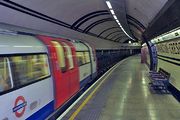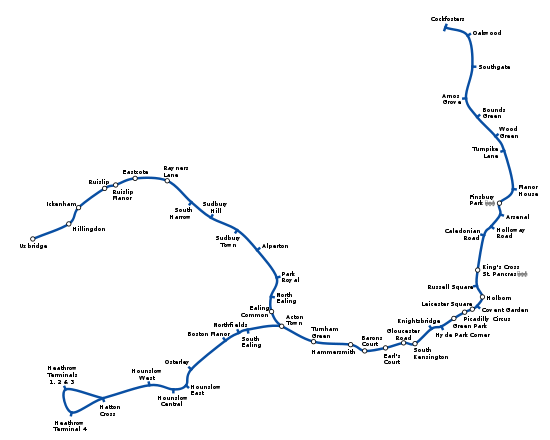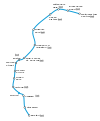King's Cross St. Pancras tube station
Entrance on Euston Road |
|
 King's Cross St. Pancras
Location of King's Cross St. Pancras in Central London |
|
| Location | Kings Cross |
|---|---|
| Local authority | London Borough of Camden |
| Managed by | London Underground |
| Owner | London Underground |
| Platforms in use | 8 |
| Accessible | |
| Fare zone | 1 |
| Interchange | London King's Cross and London St Pancras Int'l (National Rail) |
|
|
|
| London Underground annual entry and exit | |
| 2007 | 66.359 million[2] |
| 2008 | |
| 2009 | |
|
|
|
| 1863 | Opened (MR) |
| 1906 | Opened (GNP&BR) |
| 1907 | Opened (C&SLR) |
| 1968 | Opened (Victoria line) |
|
|
|
| List of stations | Underground · National Rail |
King's Cross St. Pancras is a tube station in the London Borough of Camden, on the London Underground network, serving both King's Cross and St Pancras main line stations. It is in Travelcard Zone 1.
Contents |
Interchange
King's Cross St. Pancras is the biggest interchange station on the London Underground, with six lines on four pairs of tracks:
- On the Hammersmith & City / Circle / Metropolitan lines, between Euston Square (west) and Farringdon (east). The three lines share common tracks in this area.
- On the Northern line it is on the Bank branch, between Euston (north) and Angel (south).
- On the Piccadilly line it is between Russell Square (south-west) and Caledonian Road (north-east).
- On the Victoria line it is between Euston (south) and Highbury & Islington (north).
Development
The underground part of the station underwent extensive remodelling works to increase throughflow of passengers resulting from the opening of High Speed 1. The ticket offices in the main ticket hall were closed for a long period until May 2006. The expanded station now has four entrances, the fourth being completed in November 2009.
- The main existing ticket hall (sometimes referred to as the "Tube Ticket Hall") in front of King's Cross station: this has been expanded and refurbished and will be signposted as 'Euston Road' way out from the tube lines. As of June 2009, much of the escalator access to this area is under refubishment, and passengers may have to walk a considerable distance to get from the ticket office to the platforms including one of the longest transfers in London Underground history from the Hammersmith and City Line to the Northern Line that takes passengers through the Piccadilly Line section of the station and onto a myriad of corridors.
- The Pentonville Road entrance: this used to be the ticket hall to King's Cross Thameslink station and also had direct underground passageway connections to the Victoria and Piccadilly lines. It was taken over by London Underground when the Thameslink platforms closed. The entrance is not open at weekends and the ticket office has been permanently closed with only limited passenger-operated ticket machines left in operation.
- The Western Ticket Hall (Phase 1): this is under the forecourt of St Pancras station, adjacent to Euston Road. It provides access to St Pancras Station via the new passenger facilities which have been created in St Pancras's undercroft. The Ticket Hall, which was built by a Costain / Taylor Woodrow Construction joint venture, opened on 28 May 2006.
- The Northern Ticket Hall (Phase 2): this is west of King's Cross station platform 8, underneath the new main concourse. The London Underground ticket hall and associated connections to the deep-level tube lines were opened on 29 November 2009. The hall is convenient for the proposed King's Cross Central development and has a direct connection to the transverse passageway of St Pancras mainline station and is signposted as the 'Regent's Canal' way out from the tube lines.

History

The first underground station at King's Cross opened as part of the original section of the Metropolitan Railway in 1863 and was rearranged in 1868 and 1926. New platforms for the sub-surface lines of the Underground were opened about 400 m (440 yd) to the west in 1941 to make interchanging between the sub-surface lines and the deep tube lines easier; part of what remains of the old station is located at the former King's Cross Thameslink station, which has been wholly disused since 9 December 2007 when the Thameslink service moved to St Pancras International. One of the long-disused original platforms may be seen from Underground trains travelling between the present station and Farringdon.
The Great Northern, Piccadilly and Brompton Railway (GNP&BR, now part of the Piccadilly line) platforms opened with the rest of the line in December 1906, while the City & South London Railway (C&SLR, now part of the Northern line) arrived in May 1907. The Victoria line platforms came into use on 1 December 1968 with the opening of the second phase of the line. The Victoria line escalators cut through the location of the original Piccadilly line lifts.

On 18 November 1987 the station was the scene of the devastating King's Cross fire. The cause was attributed to a lighted match falling into, and setting fire to, an escalator machine room, combined with a then-unknown fire phenomenon known as the Trench effect, which caused the fire to suddenly and violently explode into the station, killing thirty-one people. As a result, fire safety procedures on the Underground were tightened, staff training was improved and escalators with wooden steps were replaced. The existing prohibition of smoking throughout the London Underground network was tightened as a result. Due to the extensive damage caused by the fire, it took over a year to repair and reopen the station; the Northern line platforms and the escalators from the ticket hall to the Piccadilly line remained closed until 5 March 1989.
On 7 July 2005, as part of a co-ordinated bomb attack, an explosion in a Piccadilly line train travelling between King's Cross St Pancras and Russell Square resulted in the deaths of at least 26 people.
Future proposals
Crossrail 2
Since 1991, a route for a potential Crossrail 2 has been safeguarded, including a connection at King's Cross St. Pancras.[3]. The proposed scheme would offer a second direct rail connection between King's Cross and Victoria in addition to the existing Victoria line. The locations for any new stations on the route will depend on the loading gauge of the final scheme. In the 2007 safeguarded route, the next stations would be Tottenham Court Road and Angel.
York Road
In 2005 a business case was prepared to re-open the disused York Road tube station on the Piccadilly line, to serve the Kings Cross Central development and help relieve congestion at King's Cross St Pancras.[4] York Road station closed in 1932 and is located about 600 m (660 yd) north of King's Cross St Pancras.
Transport links
London bus routes 10, 17, 30, 45, 46, 59, 63, 73, 91, 205, 214, 259, 390, 476 and night route N63, N73 and N91.
See also
- 7 July 2005 London bombings
- King's Cross fire
- London King's Cross railway station
- St. Pancras railway station
Gallery
|
Roundel on clockwise Circle, Metropolitan, Hammersmith & City line platform |
Clockwise Circle, Metropolitan, Hammersmith & City line platform, looking clockwise |
Roundel on northbound Northern line platform |
Northbound Northern line platform looking south |
References
- ↑ "Step free Tube Guide". Transport for London. December 2009. http://www.tfl.gov.uk/assets/downloads/step-free-tube-guide-map.pdf. Retrieved 8 February 2010.
- ↑ 2.0 2.1 2.2 "Customer metrics: entries and exits". London Underground performance update. Transport for London. 2003-2009. http://www.tfl.gov.uk/tfl/corporate/modesoftransport/tube/performance/default.asp?onload=entryexit. Retrieved 22 May 2010.
- ↑ London Borough Islington, Crossrail 2: Scheme description, retrieved 2008-03-16
- ↑ "York Road Station Re-opening - Business Case Analysis" (PDF). 2005. Halcrow Group Limited. p. 6. http://www.kingscrossenvironment.com/files/york_road_business_case_report__final__2sided.pdf. Retrieved 25 February 2010. "The objective would be to ensure that public transport users travelling from the KCC development would benefit from travelling via York Road Station rather than using King’s Cross St Pancras Station. This in turn leads to the subobjective of providing congestion relief for King’s Cross St Pancras Station."
External links
- London Transport Museum photographic collection
- More photos of King's Cross St. Pancras
- Schematic plan of station following completion of Northern Ticket Hall in November 2009
| Preceding station | London Underground | Following station | ||
|---|---|---|---|---|
|
Euston Square
towards Hammersmith
|
Circle line |
Farringdon
towards Edgware Road
|
||
| Hammersmith & City line |
Farringdon
towards Barking
|
|||
|
Euston Square
towards Amersham, Chesham, Uxbridge
or Watford |
Metropolitan line |
Farringdon
towards Aldgate
|
||
|
Euston
towards Edgware, Mill Hill East
or High Barnet |
Northern line
Bank branch
|
Angel
towards Morden
|
||
|
Russell Square
towards Uxbridge or Heathrow Airport
(Terminal 4 or Terminal 5) |
Piccadilly line |
Caledonian Road
towards Cockfosters
|
||
|
Euston
towards Brixton
|
Victoria line |
Highbury & Islington
towards Walthamstow Central
|
|
||||||||||||||||||||||||||||||||||||||||||||||||||||||||||||||||||||||||||||||||||||||||||||||||||||||||||||||||||||||||||||||||||||||||||||||||||||||||||||||||||||||||||||||||||||||||||||||||||||||||||||||||||||||||||||||||||||||||||||||||||||||||||||||||||||||||||||||
|
|||||||||||||||||||||||||









